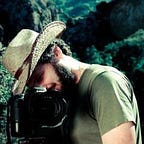“Lord of the Rings,” as it could be told in five films
REVISED 11/2017: In light of the speculation of a TV adaptation, these five parts could serve as TV seasons rather than films.
NOTE: This is a very rough outline. It assumes a fairly deep knowledge of Tolkien.
Part one: “The Lord of the Rings”
Opens on: Sauron held captive in Numenor, tempting the Numernoreons to their doom. Numenor is destroyed by the great wave and the seas are sundered. In Minas Tirith, Faramir awakes from a dream of this.
Action covered: From Bilbo’s farewell party, to the council of Elrond.
Ending: At the Counsel in Rivendell, Elrond recounts the history of the ring. We see it cut from Sauron’s hand and Isildur’s decision to take it. The Fellowship is chosen.
Why? Illustrate the larger context in which the story takes place. Not just flashbacks for their own sake, but to show how what we are seeing is only one part of an ongoing story. The forming of the Fellowship at Rivendell thus becomes climactic and is given the weight it deserves, because we are learning the history of the Ring and the incredibly high stakes of the quest, and how Isildur’s decision to take it led us to where we are now. This also sets up an opening bookend for the story of Isildur’s line, which closes when Aragorn takes the throne in part 5. Now it’s not just an expedient scene to gather the main characters together.
(As a bonus, in the opening we get to see Sauron in his “pleasing” form, walking and talking, instead of always being just a scary eyeball.)
Part two: “The White Wizard”
Action covered: From the Fellowship’s setting out from Rivendell, to Gandalf’s reunion with the Hunters.
Ending: It is revealed Gandalf has returned. We see, in flashback, his fight with the Balrog, his traveling “out of time” and being reborn atop Zirak-Zigil. A world spanning shot of Middle Earth from above.
Why? The rebirth of Gandalf is incredibly important, as a turning point in this story, and in the history of Middle Earth. It’s also incredibly cinematic and dramatic, and shouldn’t be given short shrift as “Hey I’m back!”
Part three: “The Two Towers”
Action covered: Most of the action of the book “The Two Towers.” Treebeard, Saruman’s defeat and Sam and Frodo’s journey with Gollum to the gate of Mordor.
Ending: Intercut between Sam and Frodo at the Black Gate and the Palantirs of Gondor, Isengard and Barad Dur (foreshadowing the fall of Denethor.)
Why? Tension is building. The Palantirs are another part of the larger story that connect Numenor, Orthanc, Mordor, and Gondor. We get our first glance of Mordor in all its power and see what the Fellowship (and Gondor) are really up against.
Part four: “The Pale King”
Action covered: The war of Mordor against Gondor. Frodo and Sam come to the brink of Mordor but are betrayed by Gollum, and Frodo is captured.
Ending: The King of the Nazgul falls while Frodo is betrayed by Gollum and seemingly killed by Shelob (called back by Gollum’s redemption in part five)
Why? The King of the Nazgul is another character who spans the history of Middle Earth and helps put the story in its larger context. His wounding with the sword from the Barrow is a direct connection to the men of Westernesse and the First and Second Ages. Throughout all the films, we see that the battle being fought in the Third Age is part of a larger story and a longer conflict.
Part five: “The Grey Havens”
Action covered: The march of the Captains of the West to Mordor, Frodo’s destruction of the Ring, and the end of Third Age in Middle Earth.
Ending: We speed forward through time and see all the characters age and either pass away or depart into the West. In the end, King Elessar passes, Arwen leaves Gondor and goes to her rest in Lorien, and Gimli and Legolas sail from the Grey Havens.
Why? Although it’s only covered in the appendix of the novel, this is the end of the Fellowship, the end of the Third Age, and the end of the story. All the talk of “too many endings” is because the real ending was omitted. It’s not a story about big battles.
The end of the Third Age is preordained when the Ring is destroyed. Sauron falls, but the power of the Three is also ended, as is the time of Elves (and Wizards) in Middle Earth. The destruction of the Ring and Sauron is not the end; it’s only the beginning of the end. If it was a simple story about Good defeating Evil, it could end with the Ring going into the fire and Aragorn being crowned. But Tolkien created something much more complex and bittersweet.
Seeing the characters age, die, or go into the West concludes the story of the Ring that began before any of these characters (except maybe Elrond, Galadriel, Treebeard and Tom Bombadil) were born. It’s a huge story that’s incredibly informed by what came before, it doesn’t make sense for it to stop dead when the “action” wraps up.
Overall goal: dramatize the setting, the history, and the significance of each new place, event, character and object, and its place in the larger story that this is only a small part of. Tolkien created not just a story but a world — honor that. Show the “big battles,” but not just for the stake of staging a big battle. Focus on what the story is about: The end of the Third Age in Middle Earth, and everything bittersweet that the victory over Sauron and the destruction of the Ring entails.
Last but certainly not least: Zero (0) “dwarf tossing” jokes.
